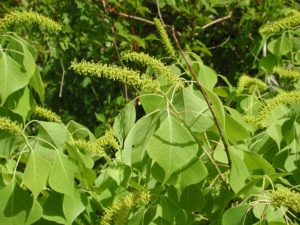Non-Native

Triadica sebifera
1. Physical Management Options
Chinese tallow can cut and rooted, but it can be very difficult to control physically because it will regrow from its root fragments and seeds.
2. Biological Management Options
At this time, there are no available biological controls for Chinese tallow.
Herbicide Control Options
Always read the product label for directions and precautions, as the label is the law. Click on the name of the product to see the label. Read the label for specific water use restrictions.
The active ingredients that have been successful in treating Chinese tallow that have aquatic registrations (other terrestrial registered herbicides may work well but cannot be used in aquatic sites) include:
- Glyphosate (Rated: Good)
- Triclopyr (Rated: Excellent)
- Imazamox (Rated: Excellent)
- Imazapyr (Rated: Excellent)
1) Glyphosate
Liquid glyphosate formulations have been effective on Chinese tallow above the water line, but ineffective on plants in the water. They are broad spectrum, systemic herbicides. Systemic herbicides are absorbed and move within the plant to the site of action. Systemic herbicides tend to act more slowly than contact herbicides. An aquatically registered surfactant (see the label) will have to be added to the glyphosate solution for good results.
Common trade or product names include but are not limited to:
2) Triclopyr
Liquid triclopyr formulation is a selective broadleaf, systemic herbicide. Systemic herbicides are absorbed and move within the plant to the site of action. Systemic herbicides tend to act more slowly than contact herbicides. An aquatically registered surfactant (see the label) will improve the effectiveness of triclopyr.
Common trade or product names include but are not limited to:
3) Imazamox
Imazamox is a broad spectrum, systemic herbicide. Systemic herbicides are absorbed and move within the plant to the site of action. Systemic herbicides tend to act more slowly than contact herbicides. An aquatically registered surfactant (a substance that will release the surface tension) is needed for application.
Common Trade of product names include but are not limited to:
4) Imazapyr
The active ingredient, imazapyr, inhibits the plant enzyme AHAS (acetohydroxyaced synthase). Habitat is a systemic herbicide that is effective on post-emergent floating and emergent aquatic vegetation. Imazapyr is effective at low-volume rates and does not contain heavy metals, organochlorides or phosphates, making it safe to humans and livestock. Habitat requires the use of a spray adjutant when applying on post-emergent vegetation.
Common trade or product names include but are not limited to:
Precautions
One danger with any chemical control method is the chance of an oxygen depletion after the treatment caused by the decomposition of the dead plant material. Oxygen depletion can kill fish in the pond. If the pond is heavily infested with weeds, it may be possible (depending on the herbicide chosen) to treat the pond in sections and let each section decompose for about two weeks before treating another section. Aeration, particularly at night, for several days after treatment may help control the oxygen depletion.
One common problem in using aquatic herbicides is determining area and/or volume of the pond or area to be treated. To assist you with these determinations see SRAC #103 Calculating Area and Volume of Ponds and Tanks.
Many aquatically registered herbicides have water use restrictions (See General Water Use Restrictions).
To see the labels for these products click on the name. Always read and follow all label directions. Check label for specific water use restrictions.
Cultivation Options
While Chinese tallow is a cultivated ornamental, it should not be planted in areas where it could spread into non-urban environments. It is a very invasive plant that should not be spread. Non-native plants threaten the native organisms in an area. They may alter the food chain and/or push their native competitors out of the area.
This plant is not native to North America, but has naturalized in much of the United States. While it is not illegal to possess this plant in Texas, it should not be introduced into new water bodies and should be treated with herbicide when present.
Questions?
If you need assistance, contact the Ag & Natural Resources agent in your county or hire a professional.